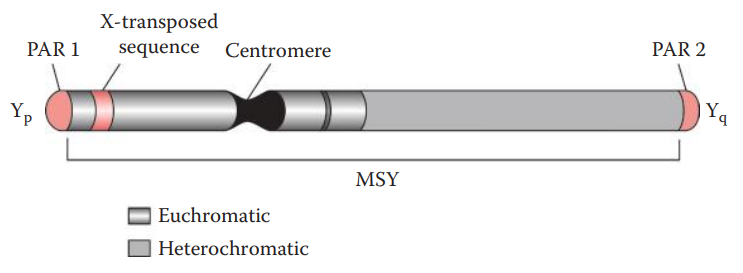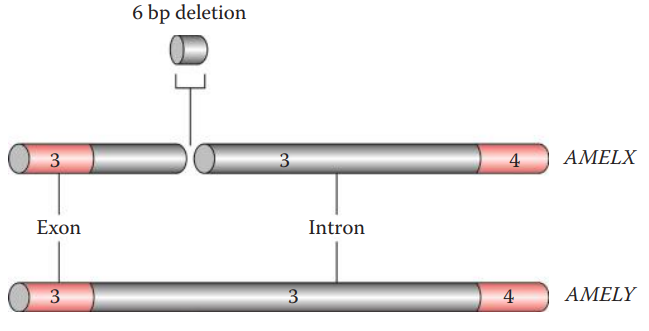
Chapter 21: Sex Chromosome Haplotyping and Gender Identification
21.1: Y Chromosome Haplotyping
Human Y Chromosome Genome
Patrilineage: The Y chromosome is inherited from the father and is passed on to all male offspring.
Pseudoautosomal Regions (PARs): Homologous nucleotide sequences that are present on the X and Y chromosomes.
PAR1: It is located on the terminal region of the short arm. It comprises 2.6 Mb. Twenty-four genes have been identified within the PAR1.
PAR2: It is located at the tip of the long arm. It comprises 320 kb, with only four genes identified so far.
Male-Specific Y Region: The remainder of the Y chromosome.
Polymorphic Sequences
DYF155S1: The first characterized VNTR at the human Y chromosome.
It consists of an array of AT-rich repeats at 25 bp per unit repeat.


Y-STR
Y-STRs used in forensic DNA testing are male specific and are thus useful in the investigation of sexual assault cases involving male suspects.
The technique can be used for paternity testing and the identification of missing persons.
The major disadvantage of Y-STR loci is that their discriminating power is lower than that of autosomal loci. Because Y chromosome loci are linked, the product rule for statistical calculations for profile probability does not apply.
Haplotypes: Alleles of Y-STR loci linked or inherited together.
In 1997, the European minimal haplotype locus set, also known as the minimal haplotype loci, was recommended by the International Y-STR User Group for forensic applications.
21.2: X Chromosome Haplotyping
X-chromosomal STR (X-STR) profiling is a useful tool in kinship testing in forensic investigations.
Homologous recombination between the X and Y chromosomes is restricted to the homologous PARs.
The paternal X chromosome is inherited by daughters as haplotypes.
Homologous recombination can occur between two X chromosomes in the mother– child transmission.
Recombination Fraction: The percentage of recombinants resulting from chromosomal crossover between two loci during meiosis among all the offspring.
21.3: Sex Typing for Gender Identification
Amelogenin Locus
This region encodes extracellular matrix proteins involved in tooth enamel formation.
Amelogenesis Imperfecta: A disorder that causes abnormal formation of tooth enamel in both primary and permanent teeth.
The AMEL locus has two homologous genes:
AMEL X: AMEL locus which is located on the human X chromosome.
AMEL Y: AMEL locus which is located on the human Y chromosome.


Other Loci
Sex-determining region Y (SRY) gene: Encodes a transcription factor that plays a role in the regulation of sex determination toward male development.
The SRY protein contains a DNA-binding domain known as the HMG box.
SOX3: An SRY-related HMG box-containing gene, has been identified at Xq27.1 of the X chromosome, which shares sequence homology with SRY.
TSPY Locus: It encodes the testis-specific protein Y-encoded gene that is only expressed in the testis and may play a role in spermatogenesis.
DYS14: A marker utilized for the characterization of the TSPY locus.
TSPY-like (TSPYL) gene: It has been identified on the short arm of the X chromosome and is designated as TSPYL2.
TSPYL2: A single-copy gene per X chromosome and is 6.3 kb in length, consisting of 7 exons and 6 introns.
DXYS156: A polymorphic pentanucleotide STR. It is located at the pseudo-autosomal region of both X and Y chromosomes, is another candidate marker used for sex typing.
DXYS156 Y: Alleles that have an additional adenine insertion in the repeat units of STR.
Steroid sulfatase (STS) gene: Encodes an enzyme that catalyzes the conversion of sulfated steroid precursors to biologically active steroids such as estrogens and androgens.
Chapter 21: Sex Chromosome Haplotyping and Gender Identification
21.1: Y Chromosome Haplotyping
Human Y Chromosome Genome
Patrilineage: The Y chromosome is inherited from the father and is passed on to all male offspring.
Pseudoautosomal Regions (PARs): Homologous nucleotide sequences that are present on the X and Y chromosomes.
PAR1: It is located on the terminal region of the short arm. It comprises 2.6 Mb. Twenty-four genes have been identified within the PAR1.
PAR2: It is located at the tip of the long arm. It comprises 320 kb, with only four genes identified so far.
Male-Specific Y Region: The remainder of the Y chromosome.
Polymorphic Sequences
DYF155S1: The first characterized VNTR at the human Y chromosome.
It consists of an array of AT-rich repeats at 25 bp per unit repeat.


Y-STR
Y-STRs used in forensic DNA testing are male specific and are thus useful in the investigation of sexual assault cases involving male suspects.
The technique can be used for paternity testing and the identification of missing persons.
The major disadvantage of Y-STR loci is that their discriminating power is lower than that of autosomal loci. Because Y chromosome loci are linked, the product rule for statistical calculations for profile probability does not apply.
Haplotypes: Alleles of Y-STR loci linked or inherited together.
In 1997, the European minimal haplotype locus set, also known as the minimal haplotype loci, was recommended by the International Y-STR User Group for forensic applications.
21.2: X Chromosome Haplotyping
X-chromosomal STR (X-STR) profiling is a useful tool in kinship testing in forensic investigations.
Homologous recombination between the X and Y chromosomes is restricted to the homologous PARs.
The paternal X chromosome is inherited by daughters as haplotypes.
Homologous recombination can occur between two X chromosomes in the mother– child transmission.
Recombination Fraction: The percentage of recombinants resulting from chromosomal crossover between two loci during meiosis among all the offspring.
21.3: Sex Typing for Gender Identification
Amelogenin Locus
This region encodes extracellular matrix proteins involved in tooth enamel formation.
Amelogenesis Imperfecta: A disorder that causes abnormal formation of tooth enamel in both primary and permanent teeth.
The AMEL locus has two homologous genes:
AMEL X: AMEL locus which is located on the human X chromosome.
AMEL Y: AMEL locus which is located on the human Y chromosome.


Other Loci
Sex-determining region Y (SRY) gene: Encodes a transcription factor that plays a role in the regulation of sex determination toward male development.
The SRY protein contains a DNA-binding domain known as the HMG box.
SOX3: An SRY-related HMG box-containing gene, has been identified at Xq27.1 of the X chromosome, which shares sequence homology with SRY.
TSPY Locus: It encodes the testis-specific protein Y-encoded gene that is only expressed in the testis and may play a role in spermatogenesis.
DYS14: A marker utilized for the characterization of the TSPY locus.
TSPY-like (TSPYL) gene: It has been identified on the short arm of the X chromosome and is designated as TSPYL2.
TSPYL2: A single-copy gene per X chromosome and is 6.3 kb in length, consisting of 7 exons and 6 introns.
DXYS156: A polymorphic pentanucleotide STR. It is located at the pseudo-autosomal region of both X and Y chromosomes, is another candidate marker used for sex typing.
DXYS156 Y: Alleles that have an additional adenine insertion in the repeat units of STR.
Steroid sulfatase (STS) gene: Encodes an enzyme that catalyzes the conversion of sulfated steroid precursors to biologically active steroids such as estrogens and androgens.
 Knowt
Knowt
